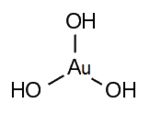Chemistry:Gold(III) hydroxide

| |

| |
| Names | |
|---|---|
| Systematic IUPAC name
Gold(3+) trihydroxide[5] | |
| Other names | |
| Identifiers | |
3D model (JSmol)
|
|
| ChemSpider | |
| EC Number |
|
PubChem CID
|
|
| UNII | |
| |
| |
| Properties | |
| H3AuO3 | |
| Molar mass | 247.9886 g mol−1 |
| Appearance | Vivid, dark yellow crystals |
| 0.00007 g/100 g | |
| Structure | |
| Trigonal dihedral at Au | |
| Hazards | |
| Safety data sheet | Oxford |
| GHS pictograms | 
|
| GHS Signal word | Warning |
| H315, H319, H335 | |
| Related compounds | |
Related compounds
|
Gold(III) chloride |
Except where otherwise noted, data are given for materials in their standard state (at 25 °C [77 °F], 100 kPa). | |
| Infobox references | |
Gold(III) hydroxide, gold trihydroxide, or gold hydroxide is an inorganic compound, a hydroxide of gold, with formula Au(OH)3. It is also called auric acid with formula H3AuO3. It is easily dehydrated above 140 °C to gold(III) oxide. Salts of auric acid are termed aurates.
Gold hydroxide is used in medicine, porcelain making, gold plating, and daguerrotypes. Gold hydroxide deposited on suitable carriers can be used for preparation of gold catalysts.[citation needed]
Gold hydroxide is a product of electrochemical corrosion of gold metalization subjected to moisture and positive electric potential; it is one of the corrosion failure modes of microelectronics. Voluminous gold hydroxide is produced from gold metalization; after the layer grows thick it may spall, and the conductive particles may cause short circuits or leakage paths. The decreased thickness of the gold layer may also lead to an increase in its electrical resistance, which can also lead to electrical failure.[7]
Preparation and reactions
Gold(III) hydroxide is produced by the reaction of chloroauric acid with an alkali, such as sodium hydroxide:[8]
- HAuCl4 + 4NaOH → Au(OH)3 + 4NaCl + H2O
Gold(III) hydroxide reacts with ammonia to produce fulminating gold, an explosive compound.[9]
It also reacts with an alkali to produce aurates(AuO2−).[10]
References
- ↑ Lide, David R. (1998), Handbook of Chemistry and Physics (87 ed.), Boca Raton, FL: CRC Press, pp. 4–59, ISBN 0-8493-0594-2
- ↑ Figuier, L (April 1848). "ART. XXIV.--OBSERVATIONS ON THE PREPARATION OF THE OXIDE OF GOLD, (AURIC ACID.)". American Journal of Pharmacy (Philadelphia) 19: 102. ProQuest 89661353.
- ↑ Kah, James C. Y.; Phonthammachai, Nopphawan; Wan, Rachel C. Y.; Song, Jing; White, Timothy; Mhaisalkar, Subodh; Ahmadb, Iman; Shepparda, Colin et al. (March 2008). "Synthesis of gold nanoshells based on the depositionprecipitation process". Gold Bulletin 41 (1): 23–36. doi:10.1007/BF03215620.
- ↑ Diaz-Morales, Oscar; Calle-Vallejo, Federico; de Munck, Casper; Koper, Marc T. M. (2013). "Electrochemical water splitting by gold: evidence for an oxide decomposition mechanism". Chemical Science 4 (6): 2334. doi:10.1039/C3SC50301A.
- ↑ "CID 11536100 - Compound Summary". PubChem Compound. USA: National Center for Biotechnology Information. 26 October 2006. Identification and Related Records. https://pubchem.ncbi.nlm.nih.gov/summary/summary.cgi?cid=11536100&loc=ec_rcs.
- ↑ "C&L Inventory". https://www.echa.europa.eu/web/guest/information-on-chemicals/cl-inventory-database/-/discli/details/87420.
- ↑ Schultze, J. Walter; Osaka, Tetsuya; Datta, Madhav (2002). Electrochemical Microsystem Technologies. CRC Press. p. 341. doi:10.4324/9780203219218. ISBN 978-0-203-21921-8. https://books.google.com/books?id=7iXwf1axhC0C&dq=%22gold+hydroxide%22&pg=PA341.
- ↑ Kawamoto, Daisuke; Ando, Hiroaki; Ohashi, Hironori; Kobayashi, Yasuhiro; Honma, Tetsuo; Ishida, Tamao; Tokunaga, Makoto; Okaue, Yoshihiro et al. (2016-11-15). "Structure of a Gold(III) Hydroxide and Determination of Its Solubility". Bulletin of the Chemical Society of Japan (The Chemical Society of Japan) 89 (11): 1385–1390. doi:10.1246/bcsj.20160228. ISSN 0009-2673.
- ↑ Perry, Dale, ed (1995) (in English). Handbook of Inorganic Compounds. p. 184. ISBN 9780849386718.
- ↑ Harry Mann Gordin (1913) (in en). Elementary Chemistry (1 ed.). the University of Wisconsin - Madison: Medico-dental Publishing Company. p. 437. https://books.google.com/books?id=FgfnAAAAMAAJ.[page needed]
 |

